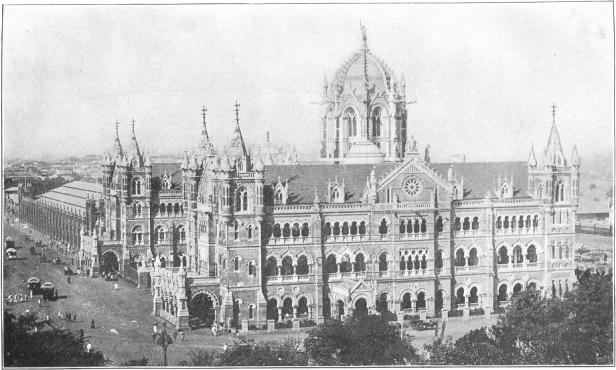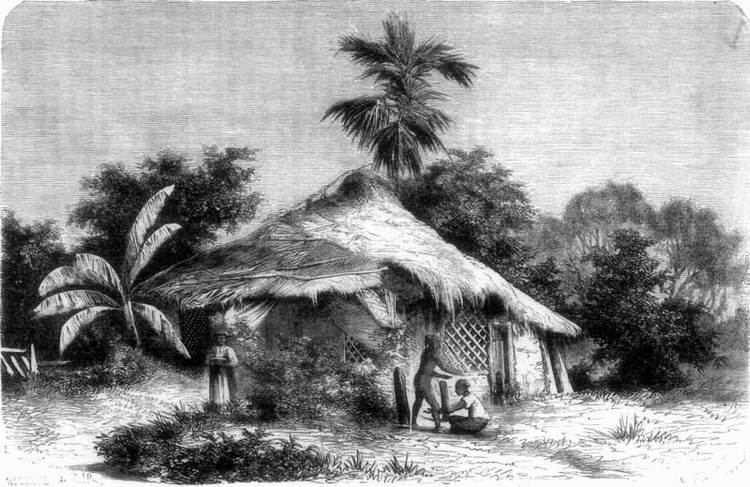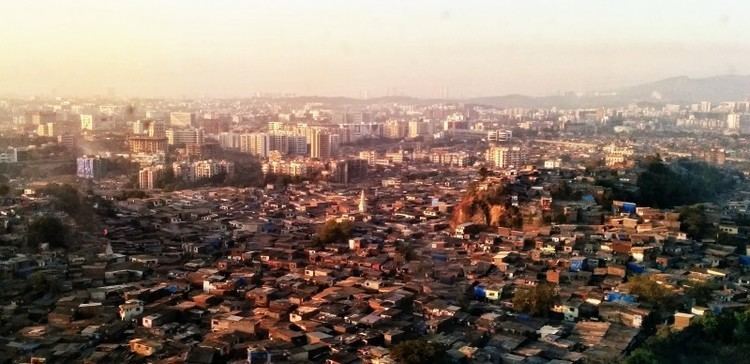Country Population 11.98 million (2001) Language spoken Marathi Area 603 km2 | State District Mumbai Suburban Mayor Vishwanath Mahadeshwar (SS) | |
 | ||
Points of interest Gateway of India, Siddhivinayak Temple - Mumbai, Mahalakshmi Temple - Mumbai, Global Vipassana Pagoda, Mount Mary Church - Bandra Colleges and Universities University of Mumbai, Indian Institute of Technology Bombay, Narsee Monjee Institute of Management Studies, Tata Institute of Social Sciences, St Xaviers College-Autonomous - Mumbai | ||
Mumbai Skyline 4K Drone View | See Mumbai Like Never Before
Mumbai ( also known as Bombay) is the capital city of the Indian state of Maharashtra. It is the most populous city in India, most populous metropolitan area in India, and the eighth most populous city in the world, with an estimated city population of 18.4 million and metropolitan area population of 20.7 million as of 2011. Along with the urban areas, including the cities of Navi Mumbai, Thane, Bhiwandi, Kalyan, it is one of the most populous urban regions in the world. Mumbai lies on the west coast of India and has a deep natural harbour. In 2009, Mumbai was named an alpha world city. It is also the wealthiest city in India, and has the highest GDP of any city in South, West, or Central Asia. Mumbai has the highest number of billionaires and millionaires among all cities in India.
Contents
- Mumbai Skyline 4K Drone View See Mumbai Like Never Before
- Map of Mumbai
- Facts
- Top ten places to visit in mumbai tourist attractions
- History
- Geography
- Economy
- Culture
- The foodie food treasures of mumbai
- References
Map of Mumbai
The seven islands that came to constitute Mumbai were home to communities of fishing colonies. For centuries, the islands were under the control of successive indigenous empires before being ceded to the Portuguese and subsequently to the British East India Company when in 1661 King Charles II married the Portuguese Catherine of Braganza, and as part of her dowry Charles received the ports of Tangier and seven islands of Bombay. During the mid-18th century, Bombay was reshaped by the Hornby Vellard project, which undertook reclamation of the area between the seven islands from the sea. Along with construction of major roads and railways, the reclamation project, completed in 1845, transformed Bombay into a major seaport on the Arabian Sea. Bombay in the 19th century was characterized by economic and educational development. During the early 20th century it became a strong base for the Indian independence movement. Upon Indias independence in 1947 the city was incorporated into Bombay State. In 1960, following the Samyukta Maharashtra movement, a new state of Maharashtra was created with Bombay as the capital. The city was renamed Mumbai in 1996.
Facts
Top ten places to visit in mumbai tourist attractions
Mumbai is the financial, commercial and entertainment capital of India. It is also one of the worlds top ten centres of commerce in terms of global financial flow, generating 6.16% of Indias GDP and accounting for 25% of industrial output, 70% of maritime trade in India (Mumbai Port Trust and JNPT), and 70% of capital transactions to Indias economy. The city houses important financial institutions such as the Reserve Bank of India, the Bombay Stock Exchange, the National Stock Exchange of India, the SEBI and the corporate headquarters of numerous Indian companies and multinational corporations. It is also home to some of Indias premier scientific and nuclear institutes like BARC, NPCL, IREL, TIFR, AERB, AECI, and the Department of Atomic Energy. The city also houses Indias Hindi (Bollywood) and Marathi film and television industry. Mumbais business opportunities, as well as its potential to offer a higher standard of living, attract migrants from all over India, making the city a melting pot of many communities and cultures.
History

Mumbai is built on what was once an archipelago of seven islands: Bombay Island, Parel, Mazagaon, Mahim, Colaba, Worli, and Old Womans Island (also known as Little Colaba). It is not exactly known when these islands were first inhabited. Pleistocene sediments found along the coastal areas around Kandivali in northern Mumbai suggest that the islands were inhabited since the Stone Age. Perhaps at the beginning of the Common era (2,000 years ago), or possibly earlier, they came to be occupied by the Koli fishing community.

In the third century BCE, the islands formed part of the Maurya Empire, during its expansion in the south, ruled by the Buddhist emperor, Ashoka of Magadha. The Kanheri Caves in Borivali were excavated in the mid-third century BCE, and served as an important centre of Buddhism in Western India during ancient Times. The city then was known as Heptanesia (Ancient Greek: A Cluster of Seven Islands) to the Greek geographer Ptolemy in 150 CE.
Between the second century BCE and ninth century CE, the islands came under the control of successive indigenous dynasties: Satavahanas, Western Kshatrapas, Abhiras, Vakatakas, Kalachuris, Konkan Mauryas, Chalukyas and Rashtrakutas, before being ruled by the Silhara dynasty from 810 to 1260. Some of the oldest edifices in the city built during this period are, Jogeshwari Caves (between 520 to 525), Elephanta Caves (between the sixth to seventh century), Walkeshwar Temple (10th century), and Banganga Tank (12th century).
King Bhimdev founded his kingdom in the region in the late 13th century and established his capital in Mahikawati (present day Mahim). The Pathare Prabhus, among the earliest known settlers of the city, were brought to Mahikawati from Saurashtra in Gujarat around 1298 by Bhimdev. The Delhi Sultanate annexed the islands in 1347–48 and controlled it until 1407. During this time, the islands were administered by the Muslim Governors of Gujarat, who were appointed by the Delhi Sultanate.
The islands were later governed by the independent Gujarat Sultanate, which was established in 1407. The Sultanates patronage led to the construction of many mosques, prominent being the Haji Ali Dargah in Worli, built in honour of the Muslim saint Haji Ali in 1431. From 1429 to 1431, the islands were a source of contention between the Gujarat Sultanate and the Bahamani Sultanate of Deccan. In 1493, Bahadur Khan Gilani of the Bahamani Sultanate attempted to conquer the islands but was defeated.
Geography
Mumbai consists of two distinct regions: Mumbai City district and Mumbai Suburban district, which form two separate revenue districts of Maharashtra. The city district region is also commonly referred to as the Island City or South Mumbai. The total area of Mumbai is 603.4 km2 (233 sq mi). Of this, the island city spans 67.79 km2 (26 sq mi), while the suburban district spans 370 km2 (143 sq mi), together accounting for 437.71 km2 (169 sq mi) under the administration of Municipal Corporation of Greater Mumbai (MCGM). The remaining area belongs to Defence, Mumbai Port Trust, Atomic Energy Commission and Borivali National Park, which are out of the jurisdiction of the BMC.

Mumbai lies at the mouth of the Ulhas River on the western coast of India, in the coastal region known as the Konkan. It sits on Salsette Island, partially shared with the Thane district. Mumbai is bounded by the Arabian Sea to the west. Many parts of the city lie just above sea level, with elevations ranging from 10 m (33 ft) to 15 m (49 ft); the city has an average elevation of 14 m (46 ft). Northern Mumbai (Salsette) is hilly, and the highest point in the city is 450 m (1,476 ft) at Salsette in the Powai–Kanheri ranges. The Sanjay Gandhi National Park (Borivali National Park) is located partly in the Mumbai suburban district, and partly in the Thane district, and it extends over an area of 103.09 km2 (39.80 sq mi).
Apart from the Bhatsa Dam, there are six major lakes that supply water to the city: Vihar, Lower Vaitarna, Upper Vaitarna, Tulsi, Tansa and Powai. Tulsi Lake and Vihar Lake are located in Borivili National Park, within the citys limits. The supply from Powai lake, also within the city limits, is used only for agricultural and industrial purposes. Three small rivers, the Dahisar River, Poinsar (or Poisar) and Ohiwara (or Oshiwara) originate within the park, while the polluted Mithi River originates from Tulsi Lake and gathers water overflowing from Vihar and Powai Lakes. The coastline of the city is indented with numerous creeks and bays, stretching from the Thane creek on the eastern to Madh Marve on the western front. The eastern coast of Salsette Island is covered with large mangrove swamps, rich in biodiversity, while the western coast is mostly sandy and rocky.
Soil cover in the city region is predominantly sandy due to its proximity to the sea. In the suburbs, the soil cover is largely alluvial and loamy. The underlying rock of the region is composed of black Deccan basalt flows, and their acidic and basic variants dating back to the late Cretaceous and early Eocene eras. Mumbai sits on a seismically active zone owing to the presence of 23 fault lines in the vicinity. The area is classified as a Seismic Zone III region, which means an earthquake of up to magnitude 6.5 on the Richter-scale may be expected.
Economy
Mumbai is Indias largest city (by population) and is the financial and commercial capital of the country as it generates 6.16% of the total GDP. It serves as an economic hub of India, contributing 10% of factory employment, 25% of industrial output, 33% of income tax collections, 60% of customs duty collections, 20% of central excise tax collections, 40% of Indias foreign trade and 4000 crore (US$630 million) in corporate taxes. Along with the rest of India, Mumbai has witnessed an economic boom since the liberalisation of 1991, the finance boom in the mid-nineties and the IT, export, services and outsourcing boom in 2000s. Although Mumbai had prominently figured as the hub of economic activity of India in the 1990s, the Mumbai Metropolitan Region is presently witnessing a reduction in its contribution to Indias GDP.
Culture
Mumbais culture is a blend of traditional festivals, food, music, and theatres. The city offers a cosmopolitan and diverse lifestyle with a variety of food, entertainment, and night life, available in a form and abundance comparable to that in other world capitals. Mumbais history as a major trading centre has led to a diverse range of cultures, religions, and cuisines coexisting in the city. This unique blend of cultures is due to the migration of people from all over India since the British period.

Mumbai is the birthplace of Indian cinema—Dadasaheb Phalke laid the foundations with silent movies followed by Marathi talkies—and the oldest film broadcast took place in the early 20th century. Mumbai also has a large number of cinema halls that feature Bollywood, Marathi and Hollywood movies. The Mumbai International Film Festival and the award ceremony of the Filmfare Awards, the oldest and prominent film awards given for Hindi film industry in India, are held in Mumbai. Despite most of the professional theatre groups that formed during the British Raj having disbanded by the 1950s, Mumbai has developed a thriving "theatre movement" tradition in Marathi, Hindi, English, and other regional languages.
Contemporary art is featured in both government-funded art spaces and private commercial galleries. The government-funded institutions include the Jehangir Art Gallery and the National Gallery of Modern Art. Built in 1833, the Asiatic Society of Bombay is one of the oldest public libraries in the city. The Chhatrapati Shivaji Maharaj Vastu Sangrahalaya (formerly The Prince of Wales Museum) is a renowned museum in South Mumbai which houses rare ancient exhibits of Indian history.
Mumbai has a zoo named Jijamata Udyaan (formerly Victoria Gardens), which also harbours a garden. The rich literary traditions of the city have been highlighted internationally by Booker Prize winners Salman Rushdie, Aravind Adiga. Marathi literature has been modernised in the works of Mumbai-based authors such as Mohan Apte, Anant Kanekar, and Gangadhar Gadgil, and is promoted through an annual Sahitya Akademi Award, a literary honour bestowed by Indias National Academy of Letters.
Mumbai residents celebrate both Western and Indian festivals. Diwali, Holi, Eid, Christmas, Navratri, Good Friday, Dussera, Moharram, Ganesh Chaturthi, Durga Puja and Maha Shivratri are some of the popular festivals in the city. The Kala Ghoda Arts Festival is an exhibition of a world of arts that encapsulates works of artists in the fields of music, dance, theatre, and films. A week-long annual fair known as Bandra Fair, starting on the following Sunday after 8 September, is celebrated by people of all faiths, to commemorate the Nativity of Mary, mother of Jesus, on 8 September.
The Banganga Festival is a two-day music festival, held annually in the month of January, which is organised by the Maharashtra Tourism Development Corporation (MTDC) at the historic Banganga Tank in Mumbai. The Elephanta Festival—celebrated every February on the Elephanta Islands—is dedicated to classical Indian dance and music and attracts performers from across the country. Public holidays specific to the city and the state include Maharashtra Day on 1 May, to celebrate the formation of Maharashtra state on 1 May 1960, and Gudi Padwa which is the New Years Day for Marathi people.
Beaches are a major tourist attraction in the city. The major beaches in Mumbai are Girgaum Chowpatty, Juhu Beach, Dadar Chowpatty, Gorai Beach, Marve Beach, Versova Beach, Madh Beach, Aksa Beach, and Manori Beach. Most of the beaches are unfit for swimming, except Girgaum Chowpatty and Juhu Beach. Essel World is a theme park and amusement centre situated close to Gorai Beach, and includes Asias largest theme water park, Water Kingdom.
